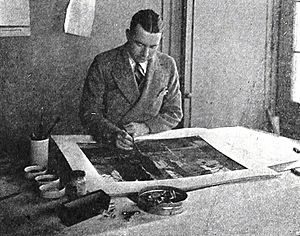William Cameron Menzies facts for kids
Quick facts for kids
William Cameron Menzies
|
|
|---|---|

William Cameron Menzies in 1925
|
|
| Born | July 29, 1896 New Haven, Connecticut, U.S.
|
| Died | March 5, 1957 (aged 60) Los Angeles, California, U.S.
|
| Education | Yale University, University of Edinburgh |
| Occupation | Production designer, film director |
| Years active | 1917–1956 |
| Awards | Best Art Direction 1928 The Dove ; Tempest Academy Honorary Award 1939 Gone with the Wind |
William Cameron Menzies (born July 29, 1896 – died March 5, 1957) was an American film expert. He was a production designer, a job title he actually created! He also worked as an art director, film director, and producer. His career lasted for nearly 50 years. He started making movies when they were silent. Later, he helped use color in films in new and exciting ways.
Contents
Early Life and Education
Menzies was born in New Haven, Connecticut. His parents, Charles and Helen, were immigrants from Aberfeldy, Scotland. He studied at Yale and the University of Edinburgh. After serving in the United States Army during World War I, he went to the Art Students League of New York.
A Creative Career in Film
Menzies started his film career at Famous Players–Lasky. This company later became Paramount Pictures. He worked on special effects and set design. He helped create the look for many famous early films. These included Robin Hood (1922) and The Thief of Bagdad (1924).
His amazing work on The Dove (1927) and Tempest (1928) earned him a special award. He won the very first Academy Award for Best Production Design. This award celebrates the best art direction in movies.
In 1929, Menzies teamed up with producer Joseph M. Schenck. They made short films that brought music to life. One of these was a short version of The Sorcerer's Apprentice.
Designing Gone with the Wind
Menzies' work on The Adventures of Tom Sawyer (1938) impressed David O. Selznick. Selznick then hired him for the huge movie Gone with the Wind (1939). Selznick trusted Menzies so much that he told everyone on the film that Menzies had the "final word." This meant Menzies decided everything about the look of the movie. This included Technicolor colors, scenic design, and set decoration.
The term "production designer" was created just for Menzies. It showed that he was in charge of the entire visual style of a film. He could take Selznick's ideas and turn them into drawings and paintings. Other directors then used these as guides.
Menzies also directed the famous "burning of Atlanta" scene in Gone with the Wind. He even re-shot a dream scene for Alfred Hitchcock's movie Spellbound (1945).
Directing Films
Beyond design, Menzies directed many dramas and fantasy films. He made two important science-fiction movies. Things to Come (1936) was based on a book by H.G. Wells. It imagined future wars and new technologies. Invaders from Mars (1953) showed fears about aliens in the 1950s.
Later Years and Death
Menzies finished his work as a producer on Around the World in 80 Days (1956). Soon after, he sadly passed away from cancer on March 5, 1957. He was buried in the Forest Lawn Memorial Park Cemetery in Glendale, California.
Awards and Honors
At the very first Academy Awards in 1929, Menzies won for Best Art Direction. He won for his work on The Dove and Tempest. He was the first person ever to win this award!
In 1940, Menzies received an Academy Honorary Award. This was for his amazing use of color to create dramatic feelings in Gone with the Wind.
Legacy and Influence
In 2005, William Cameron Menzies was honored. He was part of the first group of art directors and production designers inducted into the Art Directors Guild Hall of Fame. This shows how important his work was to filmmaking.
Some of Menzies' personal home movies are kept safe by the Academy Film Archive. They were preserved in 2015.
See also
 In Spanish: William Cameron Menzies para niños
In Spanish: William Cameron Menzies para niños
- Art Directors Guild Hall of Fame

